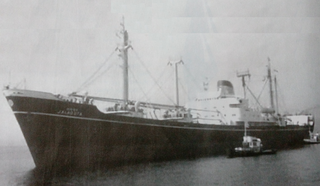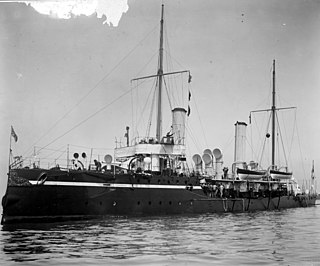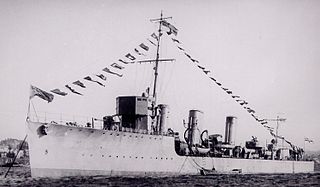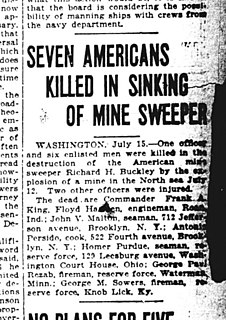The first USS Parche (SS-384/AGSS-384) was a United States Navy submarine. She bore the name of a butterfly fish, Chaetodon capistratus.

HMCS Armentières was one of twelve Battle-class naval trawlers used by the Royal Canadian Navy (RCN). Armentières entered service in 1918 near the end of the First World War on the Atlantic coast of Canada. Following the war, the ship was transferred to the Department of Marine and Fisheries for a short period before reverting to RCN service in 1923 on the Pacific coast of Canada. The ship sank in 1925, was raised and re-entered service, remaining with the fleet through the Second World War as an examination vessel at Prince Rupert, British Columbia. After the end of the war, the vessel entered mercantile service becoming A.G. Garrish in 1947, later renamed Arctic Rover in 1958, Laforce in 1962 and Polaris in 1973. The ship's registry was deleted in 1991.

HMCS Arras was one of twelve Battle-class naval trawlers that saw service with the Royal Canadian Navy (RCN). The vessel entered service in 1918 near the end of the First World War and was used for patrolling and escort duties along the Atlantic Coast of Canada. Following the war, Arras was transferred to the Department of Marine and Fisheries where the ship was used as a fisheries patrol vessel. Following the outbreak of the Second World War, the ship re-entered RCN service as a gate vessel. In 1943, the ship was heavily damaged by fire and was broken up in 1957.

HMCS Givenchy was one of twelve Battle-class naval trawlers constructed for and used by the Royal Canadian Navy (RCN) during the First World War on the east coast. Following the war, the ship was transferred to the Department of Marine and Fisheries for use as a fisheries patrol vessel on the west coast. Givenchy reentered service with the RCN in 1939 as an accommodation ship during the Second World War and was recommissioned from 1940 to 1943. After the war the ship was sold and broken up in the United States in 1952.

HMCS St Julien was one of twelve Battle-class naval trawlers constructed for and used by the Royal Canadian Navy (RCN) during the First World War. Following the war the ship was transferred to the Canadian Department of Marine and Fisheries and converted into a lightvessel. Re-designated Lightship No. 22, the ship remained as such until 1958. The ship was sold for commercial use and renamed Centennial and was in service until 1978.

SS Minnedosa was one of a pair of transatlantic steam ocean liners that were built in the United Kingdom, launched in 1917 and operated by Canadian Pacific until 1935. Her sister ship was Melita.
HMS Star was a Palmer three-funnel, 30-knot destroyer ordered by the Royal Navy under the 1896–1897 Naval Estimates. She was the eleventh ship to carry this name since it was introduced in 1643 for a 19-gun ship sold until 1652.
Naval trawlers were purpose-built or requisitioned and operated by the Royal Navy (RN), mainly during World Wars I and II. Vessels built to Admiralty specifications for RN use were known as Admiralty trawlers. All trawlers operated by the RN, regardless of origin, were typically given the prefix HMT, for "His Majesty's Trawler".
SS Empire Bunting was a 6,318 GRT cargo ship which was built in 1919. She saw service between the wars under the US flag and was transferred to the UK Ministry of War Transport in the Second World War. She made a number of cross-Atlantic voyages, often sailing in convoys. She ended her career by being sunk as a blockship on the Normandy coast, supporting the allied landings there in 1944.

Davara was a British steam fishing trawler. Launched in 1912, it was requisitioned in 1914 by the Royal Navy for service in World War I and fitted out as a minesweeper. She was returned to her owners after the war and began service as a trawler once more.

The Kil class was a class of sloops, also referred to as gunboats, built for the Royal Navy during the First World War. They were designed for anti-submarine warfare, but were completed too late in the war to be used extensively in that role. They were designed to be double-ended to confuse submarine observers, and were painted in dazzle camouflage. Following the war, the majority of the class were sold off and converted to coastal cargo vessels.

HMS Partridge was a Royal Navy Admiralty M-class destroyer constructed and then operational in the First World War, later being sunk by enemy action in 1917. The destroyer was the sixth Royal Navy vessel to carry the name HMS Partridge.

SS Jalabala was the cargo steamship owned by Scindia Steam Navigation Company Ltd., the British Indian shipping company, which was completed in 1927. She was torpedoed and sunk in the Laccadive Sea west of Cape Comorin by the German submarine U-532 with the loss of five of her 77 crew members on 11 October 1943 during World War II.

HMS Circe was a Alarm-class torpedo gunboat of the British Royal Navy. She was built by Sheerness Dockyard from 1890–1893. She was converted to a minesweeper in 1908–1909 and continued these duties during the First World War. Circe was sold for scrap in 1920.
HMS Skipjack was a Sharpshooter-class torpedo gunboat of the British Royal Navy. She was built at Chatham Dockyard from 1888–1891. She was converted to a minesweeper in 1908–1909 and continued these duties during the First World War. Skipjack survived the war and was sold for scrap in 1920.
HMS Medusa was a Medea-class destroyer of the British Royal Navy. She was one of four destroyers, of similar design to the British M-class ordered by Greece in June 1914, which the British purchased during construction owing to the outbreak of the First World War.

HMS Telemachus was a R-class destroyer of the British Royal Navy that took part in the First World War. She was built in 1916–1917 by the Scottish shipbuilder John Brown at their Clydebank shipyard. Telemachus was modified to serve as a minelayer, laying minefields in the German Bight and English Channel to restrict the operation of German submarines. The ship survived the war and was sold for scrap in 1927.

HMS Ready was a destroyer of the M class which served with the Royal Navy. Launched by Thornycroft on 14 October 1916, the vessel was the one of two similar ships ordered as part of the Fifth War Construction Programme. They differed from the remainder of the M class in having more powerful engines. On commissioning, Ready operated within the Grand Fleet until it was disbanded at the end of the First World War. The vessel was credited with helping to sink a German Q-ship in 1917. After the war, the destroyer was initially transferred to HMNB Portsmouth, but was retired and sold to be broken up on 13 July 1926 after almost a decade of service as part of a preparation for a fleet of new destroyers.

HMS Raider was the second of a class of sixty two R-class destroyers operated by the Royal Navy. Launched on 17 July 1916, the vessel served with the Grand Fleet during World War I. The destroyer was built as part of the preceding M-class but was equipped with geared turbines which improved efficiency and increased range. The ship was involved in anti-submarine patrols, but did not sink any German submarines. After the war, the destroyer initially moved to Harwich and was briefly stationed in Ireland after the Irish Civil War. In 1923, the Navy decided to retire the older destroyers in the fleet and, although initially spared, Raider was decommissioned and sold to be broken up on 29 April 1927.

USS Richard Bulkeley was a minesweeping trawler leased from the British Royal Navy. Built as HMT Richard Bulkeley, the ship was a Mersey class trawler, purpose-built for service with the Auxiliary Patrol. On 12 July 1919, it was sunk by a mine while removing minefields in the North Sea.














